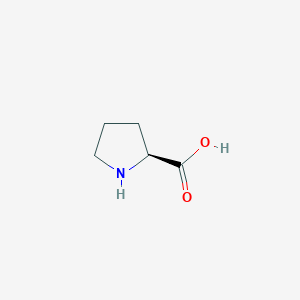Drug Information
| General Information | ||||||
|---|---|---|---|---|---|---|
| Drug ID |
DR00179
|
|||||
| Drug Name |
L-proline
|
|||||
| Synonyms |
(-)-(S)-Proline; (-)-2-Pyrrolidinecarboxylic acid; (-)-Proline; (-)-Proline (S)-2-Carboxypyrrolidine; (2S)-pyrrolidine-2-carboxylic acid; (L)-PROLINE; (S)-2-Carboxypyrrolidine; (S)-2-Pyrrolidinecarboxylic acid; (S)-Proline; (S)-Pyrrolidine-2-carboxylic acid; 2-pyrrolidinecarboxylic acid; CB 1707; Carboxypyrrolidine; H-Pro-OH; L-(-)-Proline; L-(2,3-3H)Proline; L-Prolin; L-Proline (JAN); L-Proline, labeled with carbon-14; L-Proline-15N; L-Pyrrolidine-2-carboxylic acid; L-alpha-Pyrrolidinecarboxylic acid; PRO (IUPACabbreviation); Pro; Prolina; Prolina [Spanish]; Proline; Proline (USP); Proline (VAN); Proline [USAN:INN]; Prolinum; Prolinum [Latin]
|
|||||
| Drug Type |
Small molecular drug
|
|||||
| Indication | Dietary shortage [ICD11: 5B7Z] | Approved | [1] | |||
| Therapeutic Class |
Dietary supplement
|
|||||
| Structure |
|
 |
||||
| 3D MOL | 2D MOL | |||||
| Formula |
C5H9NO2
|
|||||
| Canonical SMILES |
C1CC(NC1)C(=O)O
|
|||||
| InChI |
InChI=1S/C5H9NO2/c7-5(8)4-2-1-3-6-4/h4,6H,1-3H2,(H,7,8)/t4-/m0/s1
|
|||||
| InChIKey |
ONIBWKKTOPOVIA-BYPYZUCNSA-N
|
|||||
| CAS Number |
CAS 147-85-3
|
|||||
| Pharmaceutical Properties | Molecular Weight | 115.13 | Topological Polar Surface Area | 49.3 | ||
| Heavy Atom Count | 8 | Rotatable Bond Count | 1 | |||
| Hydrogen Bond Donor Count | 2 | Hydrogen Bond Acceptor Count | 3 | |||
| XLogP |
-2.5
|
|||||
| PubChem CID | ||||||
| PubChem SID |
10248984
, 10508477
, 14710669
, 15146482
, 15194368
, 17435868
, 24882005
, 24887885
, 24887886
, 24898097
, 24898677
, 24898986
, 24901637
, 24902491
, 3135874
, 3448
, 41102174
, 4253464
, 46223069
, 46504839
, 46506858
, 49856395
, 50108816
, 57288676
, 57346151
, 57652885
, 57652886
, 57654568
, 608065
, 6436528
, 6436535
, 6436537
, 77943168
, 7847103
, 7887166
, 7890050
, 81044534
, 81067296
, 8144250
, 838056
, 841800
, 85164895
, 85182322
, 85201946
, 87574669
, 92298421
, 92710581
, 96021916
, 96100167
, 99206182
|
|||||
| ChEBI ID |
ChEBI:17203
|
|||||
| TTD Drug ID | ||||||
| DT(s) Transporting This Drug | BGT1 | Transporter Info | Na(+)/Cl(-) betaine/GABA transporter | Substrate | [2] | |
| LAT2 | Transporter Info | L-type amino acid transporter 2 | Substrate | [3] | ||
| PAT1 | Transporter Info | Proton-coupled amino acid transporter 1 | Substrate | [4] | ||
| PAT4 | Transporter Info | Proton-coupled amino acid transporter 4 | Substrate | [5] | ||
| PROT | Transporter Info | Sodium-dependent proline transporter | Substrate | [6] | ||
| References | ||||||
| 1 | L-proline was approved by FDA. The official website of the U.S. Food and Drug Administration. (2019) | |||||
| 2 | Interpreting metabolomic profiles using unbiased pathway models. PLoS Comput Biol. 2010 Feb 26;6(2):e1000692. | |||||
| 3 | The Transporter Classification Database (TCDB): recent advances. Nucleic Acids Res. 2016 Jan 4;44(D1):D372-9. (ID: 2.A.3.8.20) | |||||
| 4 | PAT1 (SLC36A1) shows nuclear localization and affects growth of smooth muscle cells from rats. Am J Physiol Endocrinol Metab. 2014 Jan 1;306(1):E65-74. | |||||
| 5 | SLC36A4 (hPAT4) is a high affinity amino acid transporter when expressed in Xenopus laevis oocytes. J Biol Chem. 2011 Jan 28;286(4):2455-60. | |||||
| 6 | A new association between polymorphisms of the SLC6A7 gene in the chromosome 5q31-32 region and asthma. J Hum Genet. 2010 Jun;55(6):358-65. | |||||
If you find any error in data or bug in web service, please kindly report it to Dr. Yin and Dr. Li.
